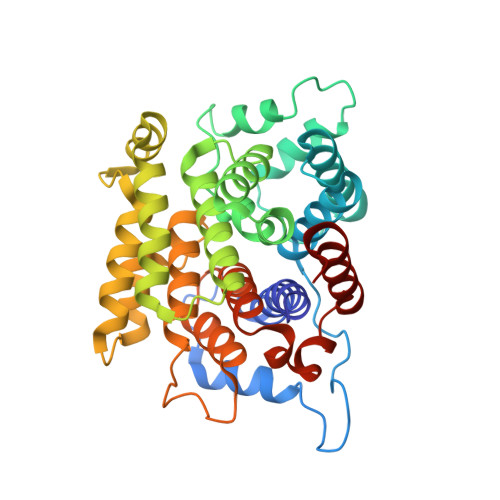Structure-function analyses reveal the mechanism of the ARH3-dependent hydrolysis of ADP-ribosylation.
Wang, M., Yuan, Z., Xie, R., Ma, Y., Liu, X., Yu, X.(2018) J Biological Chem 293: 14470-14480
- PubMed: 30045870
- DOI: https://doi.org/10.1074/jbc.RA118.004284
- Primary Citation of Related Structures:
5ZQY - PubMed Abstract:
ADP-ribosylation of proteins plays key roles in multiple biological processes, including DNA damage repair. Recent evidence suggests that serine is an important acceptor for ADP-ribosylation, and that serine ADP-ribosylation is hydrolyzed by ADP-ribosylhydrolase 3 (ARH3 or ADPRHL2). However, the structural details in ARH3-mediated hydrolysis remain elusive. Here, we determined the structure of ARH3 in a complex with ADP-ribose (ADPR). Our analyses revealed a group of acidic residues in ARH3 that keep two Mg 2+ ions at the catalytic center for hydrolysis of Ser-linked ADP-ribosyl group. In particular, dynamic conformational changes involving Glu 41 were observed in the catalytic center. Our observations suggest that Mg 2+ ions together with Glu 41 and water351 are likely to mediate the cleavage of the glycosidic bond in the serine-ADPR substrate. Moreover, we found that ADPR is buried in a groove and forms multiple hydrogen bonds with the main chain and side chains of ARH3 residues. On the basis of these structural findings, we used site-directed mutagenesis to examine the functional roles of key residues in the catalytic pocket of ARH3 in mediating the hydrolysis of ADP-ribosyl from serine and DNA damage repair. Moreover, we noted that ADPR recognition is essential for the recruitment of ARH3 to DNA lesions. Taken together, our study provides structural and functional insights into the molecular mechanism by which ARH3 hydrolyzes the ADP-ribosyl group from serine and contributes to DNA damage repair.
- From the College of Life Sciences, Hebei University, Baoding, 071000 Hebei, China.
Organizational Affiliation:


















